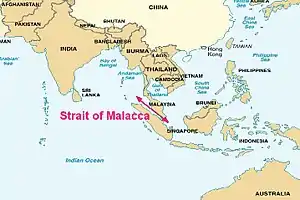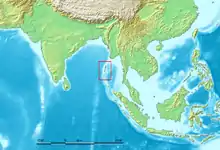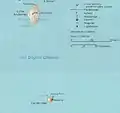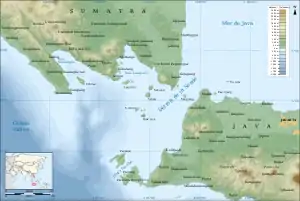Strait of Malacca
The Strait of Malacca (Malay: Selat Melaka, Indonesian: Selat Malaka, Thai: ช่องแคบมะละกา, Tamil: மலாக்கா நீரிணை, Malākkā nīriṇai, Chinese: 馬六甲海峽/马六甲海峡) or Straits of Malacca is a narrow stretch of water, 580 mi (930 km) in length, between the Malay Peninsula (Peninsular Malaysia) and the Indonesian island of Sumatra.[2] As the main shipping channel between the Indian Ocean and the Pacific Ocean, it is one of the most important shipping lanes in the world. It is named after the Malacca Sultanate that ruled over the archipelago between 1400 and 1511, the center of administration of which was located in the modern-day state of Malacca, Malaysia.
| Strait of Malacca | |
|---|---|
 The Strait of Malacca connects the Pacific Ocean to the east with the Indian Ocean to the west | |
| Location | Andaman Sea-Strait of Singapore |
| Coordinates | 4°N 100°E |
| Type | Strait |
| Native name | Malay: Selat Melaka Indonesian: Selat Malaka Thai: ช่องแคบมะละกา Tamil: மலாக்கா நீரிணை, Malākkā nīriṇai Hindi: मलक्का जलडमरूमध्य Chinese: 馬六甲海峽/马六甲海峡 |
| Basin countries | |
| Min. width | 2.8 km (1.7 mi) |
| Average depth | 25 metres (82 ft) (minimum)[1] |
| Settlements | Malacca City Port Klang Penang Medan Phuket Satun Province Aceh Riau Port Blair |
Extent
The International Hydrographic Organization define the limits of the Strait of Malacca as follows:[3]
On the West. A line joining Pedropunt, the Northernmost point of Sumatra (5°40′N 95°26′E) and Lem Voalan the Southern extremity of Goh Puket <nowiki>[</nowiki>Phromthep Cape on Phuket Island<nowiki>]</nowiki> in Siam <nowiki>[</nowiki>Thailand<nowiki>]</nowiki> (7°45′N 98°18′E).
On the East. A line joining Tanjong Piai (Bulus), the Southern extremity of the Malay Peninsula (1°16′N 103°31′E) and The Brothers (1°11.5′N 103°21′E) and thence to Klein Karimoen (1°10′N 103°23.5′E).
On the North. The Southwestern coast of the Malay Peninsula.
On the South. The Northeastern coast of Sumatra as far to the eastward as Tanjong Kedabu (1°06′N 102°58′E) thence to Klein Karimoen.
History

Early traders from Arabia, Africa, Persia, and the Southern Indian kingdoms reached Kedah before arriving at Guangzhou. Kedah served as a western port on the Malay Peninsula. They traded glassware, camphor, cotton goods, brocades, ivory, sandalwood, perfume, and precious stones. These traders sailed to Kedah via the monsoon winds between June and November. They returned between December and May. Kedah provided accommodations, porters, small vessels, bamboo rafts, elephants, as well as tax collections for goods to be transported overland toward the eastern ports of the Malay Peninsula such as Langkasuka and Kelantan. After the Tenth Century, ships from China began to trade at these eastern trading posts and ports. Kedah and Funan were famous ports throughout the 6th century, before shipping began to utilize the Strait of Malacca itself as a trade route.
In the 7th century the maritime empire of Srivijaya based on Palembang, Sumatra, rose to power, and its influence expanded to the Malay peninsula and Java. The empire gained effective control on two major choke points in maritime Southeast Asia; the Strait of Malacca and the Sunda Strait. By launching a series of conquests and raids on potential rival ports on both sides of the strait, Srivijaya ensured its economic and military domination in the region, which lasted for about 700 years. Srivijaya gained great benefits from the lucrative spice trade, e.g. the tributary trade system with China, and trade with Indian and Arab merchants. The Strait of Malacca became an important maritime trade route between India and China. The importance of the Strait of Malacca in global trade networks continued well into later centuries with the rise of the Malacca Sultanate in the 15th century, the Johor Sultanate, and the rise of the modern city-state of Singapore.
Since the 17th century, the strait has been the main shipping channel between the Indian Ocean and the Pacific Ocean. Various major regional powers have managed the straits during different historical periods.[4]
In the early 19th century, the Dutch and British empires drew an arbitrary boundary line in the strait and promised to hunt down pirates on their respective sides; that line went on to become today's border between Malaysia and Indonesia.[2]
Economic importance

From an economic and strategic perspective, the Strait of Malacca is one of the most important shipping lanes in the world.
The strait is the main shipping channel between the Indian Ocean and the Pacific Ocean, linking major Asian economies such as India, Thailand, Indonesia, Malaysia, Philippines, Singapore, China, Japan, Taiwan, and South Korea. The Strait of Malacca is part of the Maritime Silk Road that runs from the Chinese coast towards the southern tip of India to Mombasa, from there through the Red Sea via the Suez Canal to the Mediterranean, there to the Upper Adriatic region to the northern Italian hub of Trieste with its rail connections to Central Europe and the North Sea.[5][6][7][8] Over 94,000 vessels[9] pass through the strait each year (2008) making it the busiest strait in the world,[10] carrying about 25% of the world's traded goods, including oil, Chinese manufactured products, coal, palm oil and Indonesian coffee.[11] About a quarter of all oil carried by sea passes through the Strait, mainly from Persian Gulf suppliers to Asian markets. In 2007, an estimated 13.7 million barrels per day were transported through the strait, increasing to an estimated 15.2 million barrels per day in 2011.[12] In addition, it is also one of the world's most congested shipping choke points because it narrows to only 2.8 km (1.5 nautical miles) wide at the Phillip Channel (close to the south of Singapore).[13]
The maximum size (specifically draught) of a vessel that can pass through the Strait is referred to as Malaccamax, that is, for some of the world's largest ships (mostly oil tankers), the Strait's minimum depth (25 metres or 82 feet) is not deep enough. This is determined by the relatively shallow Singapore Strait, which provides passage to the Karimata Strait in the east. The next closest passageway (the Sunda Strait between Sumatra and Java) is even more shallow and narrow. Therefore, ships exceeding the Malaccamax must detour a few thousand nautical miles and use the Lombok Strait, Makassar Strait, Sibutu Passage, and Mindoro Strait instead.
Shipping hazards
Piracy has been a problem in the strait. Piracy had been high in the 2000s, with additional increase after the events of September 11, 2001.[14] After attacks rose again in the first half of 2004, regional navies stepped up their patrols of the area in July 2004. Subsequently, attacks on ships in the Strait of Malacca dropped, to 79 in 2005 and 50 in 2006.[15] Reports indicate that attacks have dropped to near-zero levels in recent years.[16]
There are 34 shipwrecks, some dating to the 1880s, in the local TSS channel (the channel for commercial ships under the global Traffic Separation Scheme). These pose a collision hazard in the narrow and shallow strait.[17]
On 20 August 2017, the United States Navy destroyer USS John S. McCain lost ten of its crew's lives in a collision with the merchant ship Alnic MC a short distance east of the strait whilst full steering capabilities had been lost and making a series of errors in attempted mitigation, its external lights being changed to "red over red" ("vessel not under command").[18]

Another risk is the annual haze due to bush fires in Sumatra, Indonesia. It may reduce visibility to 200 metres (660 ft), forcing ships to slow down in the busy strait. The strait is frequently used by ships longer than 350 metres (1,150 ft).[19]
Proposals to relieve the strait
Thailand has developed plans to divert much of the strait's traffic and hence some of its economic significance to a shorter route: the Thai government has, several times, proposed to cut a canal through the Isthmus of Kra, saving around 960 kilometres (600 mi) from the journey between the two oceans. China has offered to cover the costs, according to a report leaked to The Washington Times in 2004. Nevertheless, and despite the support of several Thai politicians, the prohibitive financial and ecological costs suggest that such a canal will not be built.
An alternative is to install a pipeline across the Isthmus of Kra to carry oil to ships waiting on the other side. Proponents calculate it would cut the cost of oil delivery to Asia by about $0.50/barrel ($3/m3). Myanmar has also made a similar pipeline proposal.
Gallery of nearby important channels

 Cocos Strait, Duncan Passage and other Indian channels
Cocos Strait, Duncan Passage and other Indian channels Cocos Strait is at the northern end of Andaman Islands in red square
Cocos Strait is at the northern end of Andaman Islands in red square Ten Degrees Channel
Ten Degrees Channel Ten Degrees Channel, closeup
Ten Degrees Channel, closeup




See also
- Geostrategic context
- Andaman and Nicobar Command
- Andaman Sea
- Bay of Bengal
- Exclusive economic zone of Indonesia
- Exclusive economic zone of Malaysia
- Exclusive economic zone of Thailand
- Exclusive economic zone of India
- Local context
References
- Malaccamax
As the name suggests, Malaccamax ships are the largest ships that can pass through the Strait off Malacca which is 25 m (82 ft) deep. As per the current permissible limits, a Malaccamax vessel can have a maximum length of 400 m (1,312ft), beam of 59 m (193.5 ft), and draught of 14.5 m (47.5 ft). Comparison of Tanker sizes - Winn, Patrick (27 March 2014). "Strait of Malacca Is World's New Piracy Hotspot". NBC News. Archived from the original on 15 March 2017. Retrieved 14 March 2017.
- Limits of Oceans and Seas (PDF) (3rd ed.). International Hydrographic Organization. 1953. p. 23. Retrieved 3 December 2018.
- Pineda, Guillermo (2012). "The Strait of Malacca as one of the most important geopolitical regions for the People's Republic of China". Academia.edu. Archived from the original on 30 January 2017 – via Academia.edu.
- Marcus Hernig: Die Renaissance der Seidenstraße (2018) pp 112.
- The Maritime Silk Road in South-East Asia.
- Could The Indian Navy Strangle China’s Lifeline In The Malacca Strait?
- Can Singapore’s shipping hub survive China’s Maritime Silk Road?
- Aljazeera.net Archived 2011-06-05 at the Wayback Machine (in English)
- Strait of Malacca - World Oil Transit Chokepoints Archived 2014-11-22 at the Wayback Machine, Energy Information Administration, U.S. Department of Energy
- Freeman, Donald B. (2003). The Straits of Malacca: Gateway or Gauntlet?. McGill-Queen's University Press. ISBN 0-7735-2515-7.. A book review citing this information can be found at University of Toronto Quarterly, Volume 74, Number 1, Winter 2004/5, pp. 528-530
- "International - U.S. Energy Information Administration (EIA)" (PDF). www.eia.gov. Archived (PDF) from the original on 22 November 2014. Retrieved 28 April 2018.
- "International - U.S. Energy Information Administration (EIA)" (PDF). www.eia.gov. Archived (PDF) from the original on 22 November 2014. Retrieved 28 April 2018.
- Raymond, Catherine (2009). "PIRACY AND ARMED ROBBERY IN THE MALACCA STRAIT: A Problem Solved?". Naval War College Review. 62: 31–42 – via Proquest.
- Piracy down 3rd year in row: IMB report Archived 2013-12-17 at the Wayback Machine, Journal of Commerce Online, January 23, 2007
- "Drastic drop in piracy in Malacca Straits - MaritimeSecurity.Asia". maritimesecurity.asia. Archived from the original on 7 November 2017. Retrieved 28 April 2018.
- "34 wrecks in sealane threaten passing ships". thestar.com.my. Archived from the original on 10 May 2007. Retrieved 28 April 2018.
- Affairs, This story was written by U.S. 7th Fleet Public. "UPDATE: USS John S. McCain Collides with Merchant Ship". navy.mil. Archived from the original on 5 November 2017. Retrieved 28 April 2018.
- Nachmani, Amikam (8 November 2003). Turkey: facing a new millennium: Coping with Intertwined Conflicts (Europe in Change). Manchester, United Kingdom: Manchester University Press. ISBN 9780719063701.
Further reading
- Borschberg, Peter, The Singapore and Melaka Straits: Violence, Security and Diplomacy in the 17th Century (Singapore and Leiden: NUS Press and KITLV Press, 2010). https://www.academia.edu/4302722
- Borschberg, Peter, ed., Iberians in the Singapore-Melaka Area and Adjacent Regions (16th to 18th Century) (Wiesbaden and Lisbon: Harrassowitz and Fundação Oriente, 2004). https://www.academia.edu/4302708
- Borschberg, Peter, ed. The Memoirs and Memorials of Jacques de Coutre. Security, Trade and Society in 17th Century Southeast Asia (Singapore: NUS Press, 2013). https://www.academia.edu/4302722
- Borschberg, Peter, ed., Journal, Memorials and Letters of Cornelis Matelieff de Jonge. Security, Diplomacy and Commerce in 17th Century Southeast Asia (Singapore: NUS Press, 2015). https://www.academia.edu/4302783
- Borschberg, Peter, "The value of Admiral Matelieff's writings for the history of Southeast Asia, c. 1600–1620", Journal of Southeast Asian Studies, 48(3), pp. 414–435. doi:10.1017/S002246341700056X
- Borschberg P. and M. Krieger, ed., Water and State in Asia and Europe (New Delhi: Manohar, 2008). https://www.academia.edu/4311610
External links
| Wikimedia Commons has media related to Strait of Malacca. |
| Library resources about Strait of Malacca |
- World oil transit chokepoints
- Maritime Security in Southeast Asia: U.S., Japanese, Regional, and Industry Strategies (National Bureau of Asian Research, November 2010)
- BBC News report on the increased security in the Straits
- "Going for the jugular" Report on the potential terrorist threat to the Straits. From the Economist, requires subscription, in the print edition June 10, 2004
- China builds up strategic sea lanes
- A report from the International Maritime Organisation on the implementation of a Straits "Marine Electronic Highway" - a series of technological measures to ensure safe and efficient use of the busy waters
- Malacca, Singapore, and Indonesia (1978) by Michael Leifer
- The Malacca Straits Research and Development Centre homepage
- Al-Jazeera: Malacca Strait nations plan air patrol
- The Strategic Importance of the Straits of Malacca for World Trade and Regional Development
- AP: Singapore warns of terror threat in Malacca Strait, 2010-03-04